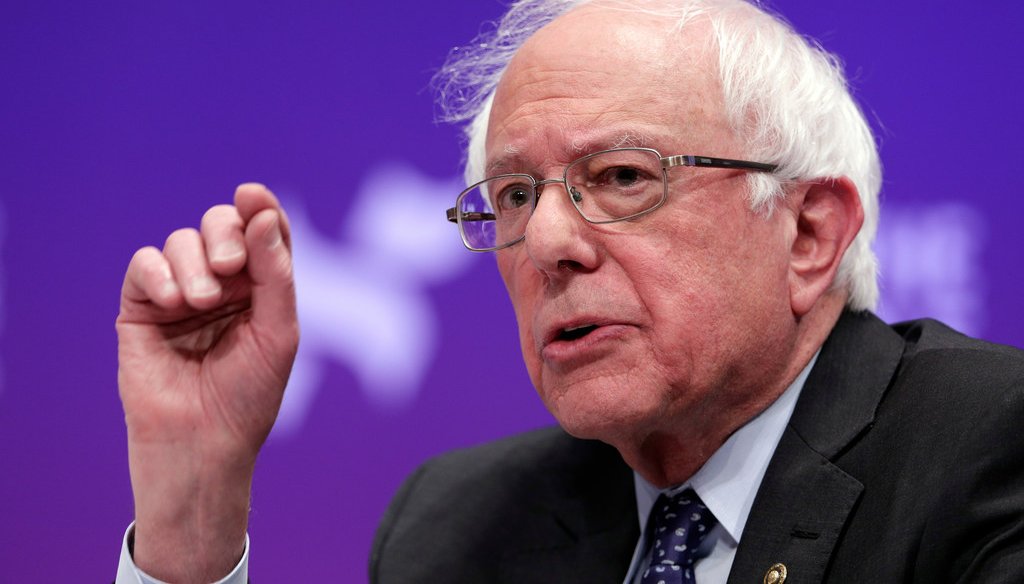



Bernie Sanders says Wisconsin payday loans have an average annual rate of 574% (AP Photo/Michael Wyke, File)
As the first debate of the Democratic primary approaches, Sen. Bernie Sanders, I-Vt., announced his policy proposal to cancel student debt. Outside the U.S. Capitol on Monday, Sanders outlined his plan to cancel $1.6 trillion in student loans by levying a tax on Wall Street financial transactions.
During the announcement, the Vermont senator used an old stump speech favorite — that university in the U.S. was mostly tuition-free throughout the 20th century — but with an addendum.
Sanders said that a federal financial assistance program for low income students, which unlike loans does not need to be paid back, covered almost the entire cost of college back in the late 1970s.
"Forty years ago, a federal Pell grant paid for nearly 80% of tuition, fees, room and board at a four-year college," Sanders said.
Sanders went on to say that though the Pell grant no longer comes close to covering the costs of college, his student debt forgiveness proposal would give the financial assistance grant a significant boost.
That made us wonder – did Pell grants really cover nearly the entire cost of attending college four decades ago? We reached out to the Sanders campaign as well as several higher education finance experts to find out.
A spokesperson for the Sanders campaign referred us to a 2017 policy brief from the Center on Budget and Policy Priorities, a progressive think tank that studies federal and state budget policies.
In that analysis, the authors write that in 2017 "Pell (covered) just 29 percent of the average costs of tuition, fees, room, and board at public four-year colleges" which was "its lowest level in more than 40 years and far below the 79 percent it covered in 1975."
Spiros Protopsaltis, an author of the brief and an associate professor of education policy at George Mason University, said he believes Sanders’ statement to be accurate.
Protopsaltis explained that in 1975 the average cost of tuition, fees and room and board at a four-year public institution was $1,779, according to College Board data compiled by the authors. The maximum Pell grant that year was $1,400 — or 79% of the total cost.
Donald Heller, the provost and vice president of Academic Affairs at the University of San Francisco, who has researched higher education finance, agrees with what Sanders said Monday – with one important caveat.
Protopsaltis’ analysis, showing the grants covering 80% of college costs, only applies to public universities, not private institutions.
"That’s an important distinction, because it covered less of the cost of a private four-year college or university," Heller said.
According to College Board data shared by Protopsaltis, the maximum Pell grant in 1975 would have only covered about 38% of the total cost of attendance at a private, four-year nonprofit school, where the average cost of tuition, fees, room and board averaged $3,682.
That’s important to keep in mind. Because the high cost of college, where public higher education is concerned, is also tied to deep funding cuts state governments have made to their college systems.
"It’s not just that Pell has been completely disinvested in. A big portion of that driver is that states have disinvested as well, which has driven tuition up," said Wesley Whistle, a senior adviser at New America’s education policy program
Sanders said that 40 years ago a "federal Pell grant paid for nearly 80% of tuition, fees, room and board at a four-year college."
While this is accurate for public four-year colleges, it is not true of private four-year institutions.
Based on the data the Vermont senator cited for his statement, a Pell grant would only cover 38% of the cost of a private university in the late 1970s — well off the nearly 80% of costs Sanders says the grants covered at a "four-year college."
While Sanders statement is accurate, it leaves out the important context that this number refers only to four-year public college. We rate this statement Mostly True.
Bernie Sanders, press conference remarks, June 24, 2019
Email with Arianna Jones, Sanders 2020 presidential campaign, June 25, 2019
Center on Budget and Policy Priorities. "Pell Grants — a Key Tool for Expanding College Access and Economic Opportunity — Need Strengthening, Not Cuts." July 27, 2017.
Phone interview with Wesley Whistle, Senior Advisor for Policy and Strategy, Education Policy Program at New America
Email correspondence with Donald Heller, Provost and Vice President of Academic Affairs at the University of San Francisco, June 25, 2019
Email correspondence with Spiros Protopsaltis, Director of EdPolicyForward at George Mason University, June 25, 2019
In a world of wild talk and fake news, help us stand up for the facts.
